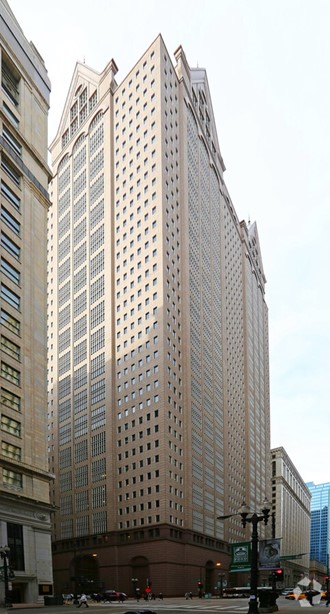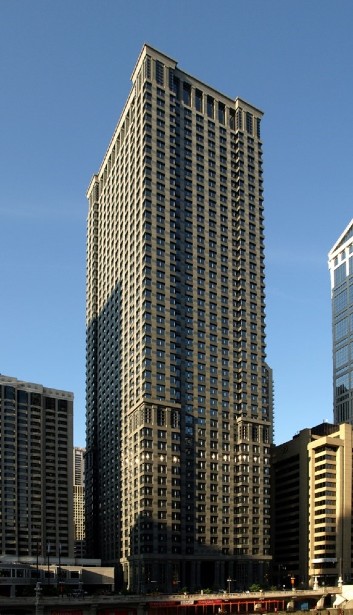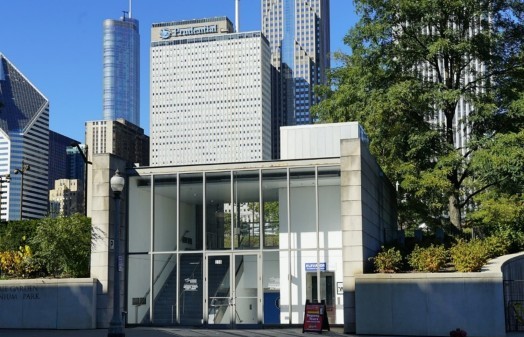by Ron Becker, Class of 2019
Beginning in 1979, Chicago’s Jay A. Pritzker and his wife Cindy began to award an annual prize to living architects. The award, funded through the family’s Hyatt Foundation, has proven perhaps the most prestigious in the architectural profession. It has frequently been referred to as the Nobel Prize of Architecture. In addition to the recognition, laureates receive a $100,000 grant and a bronze medal.

Although the Pritzker medal seeks to be awarded “irrespective of nationality, race, creed, or ideology,” it appears that Chicago has attracted more buildings designed by Pritzker Laureates than any other city. This essay will survey that group of buildings in the chronological order of the architects’ awards.
The first award was given in 1979 to Philip C. Johnson. Philip Cortelyou Johnson (1906-2005) is renowned for popularizing Modernist architecture. At the time he received this award, Johnson was moving on from Modernism to a Postmodern phase.
In Chicago, he designed a 41 story, postmodern skyscraper at 190 South LaSalle Street in the Loop. It was completed in 1987.
In 1982 the Pritzker Prize was given to Kevin Roche. Eamonn Kevin Roche (1922-2019) was an Irish-born architect who came to Chicago in 1948 to study under Mies van der Rohe at the Illinois Institute of Technology. In Chicago Roche designed the Leo Burnett Building at 35 West Wacker Drive. Slightly farther afield is the striking headquarters building complex that Roche designed for Lucent Technologies in suburban Lisle and Naperville. The Lisle building with its spectacular “satellite dish” entrance catches the eye of anyone driving along I-88.

The next year, 1983, the Pritzker Prize was given to I. M. Pei. Ieoh Ming Pei (1917-2019) is perhaps the best known of all the Pritzker Laureates. In the 1950s the City of Chicago, along with the University of Chicago, drew up plans to revitalize residential areas in Hyde Park. I. M. Pei was commissioned along with Araldo Cossutta to design two apartment buildings called the University Apartments, completed in 1961.
In 1962 the Federal Aviation Administration held a competition to design control towers for airports around the country. The FAA chose the Pei entry which consisted of modular forms that could be configured to each airport’s needs, including a 150 foot tower at O’Hare Field.
In 1987, the Pritzker Prize was given to the renowned Japanese architect Kenzo Tange (1913-2005). Most of Tange’s buildings have been in the eastern hemisphere; an exception being a building for the headquarters for the American Medical Association at 515 North State Street. This distinctive, 29-story, aluminum and glass skyscraper features a 4-story, rectangular cutout near the top. It was completed in 1991. The AMA relocated to Mies van der Rohe’s IBM Plaza along the river in 2013.
Frank O. Gehry was awarded the Pritzker Prize in 1989. The Canadian-born Frank Owen Gehry (1929- ) hardly needs an introduction because of his wildly imaginative buildings. In Chicago, he brought his style, that Lynn Becker has labeled Techno-Baroque, to his designs for the Pritzker Pavilion music center and the BP Pedestrian Bridge, both in Millennium Park.
In 1995, Tadao Ando was named the Pritzker Laureate. Tadao Ando (1941) is a self-educated Japanese architect who is most noted for working with cement but creating light-filled and airy structures that connect with nature. Tadao Ando’s first project in the United States was to design a gallery for the Art Institute of Chicago. This was completed in 1992. The Eychaner House on Wrightwood in Lincoln Park was completed in 1997. Finally, in 2018 he completed the transformation of the existing apartment building next to the Eychaner/Lee House into an exciting art exhibition space.

1998 was the year Renzo Piano received his Pritzker Prize. Renzo Piano (1937) is an Italian-born architect who is primarily known for his monumental structures. He designed the Modern Wing of the Art Institute of Chicago, as well as the Nichols Bridgeway, a pedestrian bridge that crosses Monroe Street and connects Millennium Park to the Art Institute. He also designed the south Exelon Pavilions that contain the elevators to the underground Millennium parking garage.

The next year, 1999, the Pritzker prize was given to Sir Norman Foster, founder of Foster + Partners. Norman Robert Foster (1935) is one of the most proficient and successful British architects. After designing the Apple Campus in Cupertino, California, he received commissions to design a number of their stores, including the Apple Store on Michigan Avenue.

The winner of the 2000 Pritzker Prize, Rem Koolhaus, was the third winner in a row to design a structure in Chicago. Remment Koolhaus (1944) is a Dutch-born architect. Koolhaus won a 1997 competition to design the McCormick Tribune Campus Center at IIT, completed in 2003. A 530-foot tube that encircles the Green Line “L” tracks designed to dampen the train noise is but one of the innovative features included in his design.

Please let me know if I missed any buildings.
_____________________________________________________________________________________________

CLICK HERE for more stories on The Bridge.












Great overview of Prtizker winners’ buildings in Chicago — thanks Ron!
Echoing Lance’s praise! Appreciate the depth and heights of your research. Thank you, Suzy Ruder
Thanks for this history – great work documenting Chicago’s important heritage.
Great article, Ron. Thanks!
I really enjoyed your concise and informative review of the local work of these prize-winning architects, not to mention the pictures!
Wonderful article-thank you!
Betsy Pilmer
Thanks, Ron. Really enjoyed reading this and enjoying the pictures.
I found this very informative!
Thank you Ron